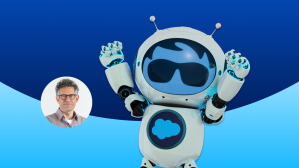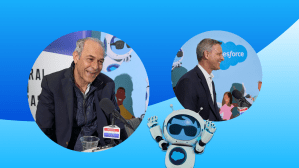Generative AI is poised to completely reshape how organizations think about data analysis. However, facilitating widespread change requires that anyone can easily visualize and understand the data.
We sat down with Christian Hagel-Sorensen, who oversees user-experience design for Tableau Pulse, to learn how generative AI is impacting data design and the way people see, understand, and act upon data across organizations. Here’s what he had to say:
Q. What makes a good data visualization?
The mark of a good visualization is the ability to understand it in a split second. Will someone get the right impression from the data visualization before their brain is able to process it? Time is money. And it costs you if your audience isn’t able to immediately and accurately comprehend what the data is saying.
Time is money. And it costs you if your audience isn’t able to immediately and accurately comprehend what the data is saying.
Christian Hagel-Sorensen, Director User Experience Design, Tableau
You also need simplicity. I believe that having two, three, or four visualizations is often better than one because smaller bits of information are usually easier to understand. Think about a run-on sentence — they usually take more time for our brains to comprehend than if they were broken into smaller, more digestible nuggets.
Tableau Pulse is designed with this in mind. We’ve stripped out information and all the visual clutter, but not the data, so the data can be grasped more quickly and accurately than if it were presented in a singular, more complex visualization.
Q. How does generative AI impact the way people relate to data?
Generative AI seems like magic. You can upload a CSV file and instantly be able to analyze it. Then you can ask the LLM to make a bar chart of two columns in the data — and it does. And that feels pretty magical. Still, it doesn’t solve a core problem for most people, which is knowing what questions to ask to get an even deeper understanding of the data they’re looking at.
In fact, roughly 70% of people aren’t well served by their data. They use it in their jobs, but it isn’t foundational to their role, and it’s not one of their core skills.
Most people who fall into this bucket are responsible for some KPIs but aren’t able to accurately share how they are doing because, while they can easily ask the first one to three questions about their data, it takes a data expert to ask questions that will uncover meatier insights.
You can tell a sales manager that they’ve sold $1,000 worth of product — and even call out that it’s 15% more than last quarter — and that’s great base-level data. But what’s really helpful is being able to pinpoint why they sold more. Being able to visualize, analyze, and understand where they can double down to get a more thorough story — like if there’s something that isn’t going well, whether the 15% increase came alongside a drop somewhere else, etc. – will help them make more informed decisions that will lead to a more positive impact over time.
With Tableau Pulse, generative AI is bringing these deeper questions forward for people who are less familiar with data — ultimately surfacing key metrics and bringing new insights forward to drive better decision-making and efficiency. We’re working to give customers the power of analytics in a way that both doesn’t feel intrusive and isn’t completely random.
Q. You have said that chatbots are not a good UI for people when it comes to data. Explain what you mean by that.
When using something like Chat GPT and opening a chatbot, there might be a couple of prompt questions that you can choose from to help get started. When you click one of those, the AI bot will answer that question … but you’re then left on your own. What questions should you ask after that?
Chatbots fail us when their guidance stops — especially when we’re mapping something that might feel like uncharted territory. We don’t want to leave our customers hanging. So we take what we’ve learned during the last two decades in analytics and apply trusted generative AI to lead you to the next best question so you’re able to squeeze as much information as possible from your data and make more informed decisions.
So we take what we’ve learned during the last two decades in analytics and apply trusted generative AI to lead you to the next best question so you’re able to squeeze as much information as possible from your data and make more informed decisions.
Christian Hagel-Sorensen, Director User Experience Design, Tableau
Q. When you have generative AI working and presenting information, what is the role of the human in the actual design piece? Will AI ever replace your job as a designer?
Steve Jobs had this amazing quote about the computer becoming a bicycle for the mind, in that they’re both innovations that can take us beyond our inherent abilities. AI is not being created to replace people. It’s being created to assist and augment — and effectively help people operate at a level they might not have known was possible. It’s about giving people superpowers in terms of being able to understand or run their businesses at a deeper level.
As a designer, I want to be accelerated. I want to be augmented. One of the things we focus so much on in design is exploring multiple paths — that’s a place where I really believe AI will help — being able to look at all of my options forward and say, ‘Okay, which of these things should I put together to create something greater than I had originally imagined.’
Q. A lot of AI companies have been under fire for AI hallucinations. Is this something that keeps you up at night?
Trust is our number one value at Salesforce and we’re diligent in making sure that we live up to that value in everything we do. This helps me sleep well at night.
However, there are a couple of things that I do think about. To start, Tableau Pulse provides an explanation along with every visualization. So when we add a textual explanation, I need to make sure that it’s in sync with what the visualization is saying and that the explanation isn’t hallucinating or delivering made-up results. These are things I’m always thinking about because we’ve spent considerable time and energy honing that. We have to make sure that the understanding is correct and that we don’t lead people astray. And that is a constant thing to be vigilant about at all times, all the time, every day in every discipline and in everything we do.
Go deeper:
- Read more about Tableau Pulse
- Learn more about Einstein Copilot for Tableau
- See how John Lewis Partnership is using Tableau Pulse to reduce returns with data-driven insights
















